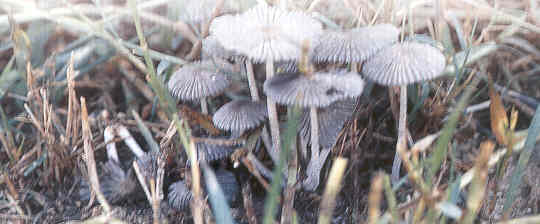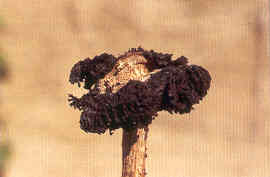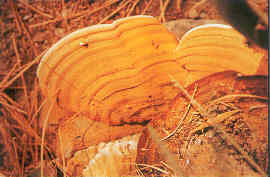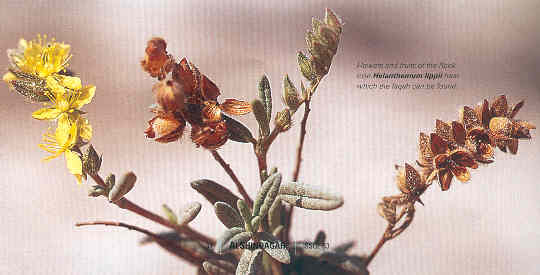|
Because
some good rain fell before December of last year, and if
January remains relatively dry, it is possible that this
March you’ll see many local people roaming around the
low shrubland along the coast, their gaze fixed on the
ground, searching for something. What they are looking
for is a sign, a small patch of cracked soil in the
neighbourhood of a certain plant – the telltale sign of
the presence of the underground mushroom that is locally
called ‘faqah’. It is considered to be a delicacy
and it is very expensive because it is rare and is
becoming ever more so. It is a fungus that grows in
symbiosis with a member of the Rockrose family (Cistaceae),
Helianthemum lippii, locally called ‘rugrug’
or ‘jeraid’. This plant grows in the narrow strip
of land that lies just inland from the beaches as well
as much less widespread in certain areas of the
mountains. Apparently the truffles obtain nourishment by
sending out filaments that penetrate the roots of the
rock rose plant. Researchers speculate that in return
the truffle produces a substance that inhibits competing
plants. The areas between Jumeirah and Jebel Ali used to
be a good finding place, but that site has now been
taken up by buildings that have come up like mushrooms!
Now the only areas that are still known to be good ‘faqah’
sites are between Ajman and Ras al Khaymah. But even
there construction sites are increasing in frequency and
extent, and soon the UAE ‘faqah’ will be the
stuff of legends.
John Feeney, a
writer/photographer from New Zealand who spent four
decades in Cairo, has dug into the truffle’s past and
tells some wonderful tales. Papyrus writings mention
that desert fungi were served to the pharaohs of Egypt,
while three thousand years later the tables of the
Fatimid caliphs in Cairo were also graced with local
truffles. Aristoteles’ pupil Theophrastus referred to
truffles in 500 BC as “a natural phenomenon of great
complexity, one of the strangest plants, without root,
stem, fibre, branch, bud, leaf or flower.”
No one has ever
managed to grow truffles under cultivation. All of them
grow wild and often in symbiosis with other plants. The
edible part of the fungus is the fruit body. The 30 or
so species of desert truffles are all members of the
Terfezia or Tirmania genera, cousins of the
white fragrant truffles of Piedmont, Alba and Umbria in
Itlay and the “black pearls of the Perigord” in France
that grow around the roots of oak and hazelnut trees.
The underground
mushroom of the desert occurs in many countries and has
many different names. In Kuwait it is called fugaa
or fagga, in Iraq and Syria they are called
kamaa (the classical Arabic name) or kima,
and in Oman either faqah, kumba or
zubaidee. In North Africa, from where the Romans
used to get their mushrooms, there was a white variety
that was called terfez and this gave them their
Latin genus name Terfezia. The English common
name is truffle, but they do not resemble the European
truffle, which are from a different botanical genus (Tuber
spp.), in appearance or taste. Local folklore
maintains that the growth of the ‘faqah’ is set
off by thunder and lightning, giving evidence of the
association with rainfall that I have observed
personally.
There are many
different varieties of desert truffles. The most famous
one is the cream-coloured ‘zubaidee’ that grows
in the Eastern province of Saudi Arabia and has a very
delicate flavour. From the same area is the ‘khalasi’,
which is black with a pinkish-ivory interior. Local
truffles are mainly brown, up to 10 cm in diameter,
knobbly, looking like a small potato. They are light in
weight with a dense structure and smell faintly of
mushroom. The truffles found near the Rock rose bushes
in the mountains apparently are much larger in size. A
local farmer once told me that he had found a ‘faqah’
that weighed more than a kilo, and when he cut it open a
snake was found inside that had used a hollow part of
the mushroom as a burrow. It was hard to imagine this,
but the farmer was adamant that it was true.
In the early
eighties, when there had been abundant early rains I
spent many hours searching the coastal shrubland in
Jumeirah. The best time to search is at dawn and dusk
when the low slanting rays of the sun will show up any
irregularity in the sand that may betray the presence of
the truffle a hand’s breadth below the surface. Even
though I was familiar with the Rockrose plant near which
the faqah grows and knew to look for the cracked
soil, I never managed to find one. It takes a practiced
eye. Emirati and Pathan fellow searchers were more
successful than I was.
Once found and
harvested, desert truffles have to be kept dark and
cool, preferably in baskets, never in plastic bags. Phil
Iddison, an expert on Mediterranean dishes, put some in
the freezer as an experiment and found that the taste
did not suffer by this treatment. Because of their
rarity and the need to be very fresh, desert truffles
can be very expensive. In good years they may cost
between 50 to 150 dhs a kilo, but if they have to be
imported from far away countries like Egypt, they may
reach a price as high as 1000 dhs a kilo.
In 1998, another
good ‘faqah’ year, I was given a handful of
mushrooms by a local friend who had found them near
Ajman. These I cleaned and sautéed as instructed, but I
found the taste insignificant that time. I assume the
taste depends on the variety of desert truffle and
possibly also on the conditions under which it has
grown.

Iddison mentions
that his first experience was also disappointing, but
that he had better luck with a heavily spiced Omani dish
called ‘kumba muqashad’ and an Emirati dish
called ‘saloona’ or ‘laham murraq’. The
latter dish is a lamb stew with spices that has to cook
on low heat for ninety minutes. By this time the ‘faqah’
has a reddish-brown colour and a strong meaty fungal
flavour. Bahrain has a dish called ‘aeesh alfaqa’a’
for truffles with rice. In Saudi Arabia they are
included in a dish cooked with eggs. In a Lebanese
recipe the truffles are cleaned thoroughly, marinated in
oil, lemon and garlic and grilled on skewers, a dish
called ‘kama meshwi’.
Feeney gives the
recipe of a Cream of Desert Truffle Soup – a gourmet’s
delight if ever there was one, according to him.
I
quote:
For
this recipe you’ll need not only a basket of white
desert truffles, but also a female camel. If the camel
isn’t handy, substitute whole milk, or, even better,
light cream.
Ingredients:
9 or 10 medium-sized white desert truffles, very fresh
4 cups whole milk or
light cream
1 small onion, peeled
and roughly chopped
2 or 3 cloves garlic,
peeled and roughly chopped
4 more cups of whole
milk or light cream
1 tablespoon unsalted
butter
2 tablespoons white
all-purpose flour
1 beef
bouillon cube
½ tablespoon granulated
sugar
¼ teaspoon cayenne
pepper
salt and freshly ground
white pepper
¼ tablespoon unsalted
butter
¾ cups light cream
Instructions
-
Immerse the truffles in cold water
for 10 minutes. Throw out the water and loose sand and
cover them with water again. Repeat. Gently massage
each truffle under running water with your fingers and
scrub them lightly with a fine brush. Rinse. Scrub and
rinse again until all sand is removed. Roughly chop
all but two of the truffles.
-
Put onion and garlic
in the first four cups of milk and boil for five
minutes. Then add the chopped truffles. Simmer gently
for another three minutes. Puree the mixture in a
blender and set aside.
-
Make a white roux by
heating the remaining cups of milk very hot but not
boiling. Melt one tbsp of butter in another pan and
when it starts to froth, turn down the heat and stir
in the flour until it is all absorbed by the butter
and becomes a thick paste. Pour in the very hot milk,
half a cup at a time. Keep stirring until a smooth,
creamy sauce is achieved. Let it simmer gently for
another 10 minutes.
-
Slowly stir in the
pureed truffle mixture until it is absorbed into the
sauce. Drop in the bouillon cube and the sugar. Add
salt and white and cayenne pepper. Stir in the three
quarters of a cup of cream and the quarter tablespoon
of butter for finishing.
-
Just before serving
grate the two remaining truffles very fine directly
into the soup.
-
Kept in a sealed jar
the finished soup will keep its truffle flavour for
several days.
(I think it would be
interesting to put the following remarks in a separate
box with small prints of as many of the pictures of the
B-series in order to show the great variety – you could
do them like a row of contact prints of the slides…)
 

Besides the
underground mushrooms the desert is home to quite a few
species of mushrooms of the ordinary above-ground kind.
I have photographic records of more than 20 different
species. As far as I know none of these have been
identified as yet and nothing is known about whether
they are edible or not. The trouble is that in order to
identify a mushroom, one needs specimens of young,
mature and old mushrooms as well as a print of the spore
pattern collected from a mature specimen. The desert
mushrooms grow often singly and far apart in time and
space, so that a collection as described above is
impossible. In rare cases a mushroom may be identified
from a single specimen. This was the case with a very
strange mushroom that looked exactly like a golf-tee. It
was collected in the middle of the sand dunes south of
the Sharjah-Ras al Khaymah road by a friend who thought
there was a rusted nail sticking out of the sand. The
mushroom had an underground part that was at least
thirty times as long and equally thick as the part above
ground. When sent to a university in the UK it caused
quite a stir because this species of mushroom had only
been recorded from the Indian subcontinent so far. There
are several species of garden mushroom with long thin
stems that grow in groups. They resemble European meadow
mushrooms that are often edible. Another mushroom we
called “hershey’s kisses” because with their glossy
chocolate-brown, conical caps they resembled the famous
candy. There are white mushrooms with round caps that
emit their spores from the center of the cap like puff
balls, and white club-shaped mushrooms with scaly
exteriors. There are several species of brackets, some
golden, others black, often growing on the ghaf
tree. I have found huge irregularly shaped fungi on
salty soil near the coast as well as tiny
delicate-stemmed “fairy stools” among rocks in the
mountains. Apart from the garden mushrooms, none of the
mushrooms I have recorded could have been imported, as
they were mainly found far away from human interference.
Some young Emirati with a keen interest and a spirit of
perseverance and adventure should make the mushrooms of
the UAE a study subject! | 